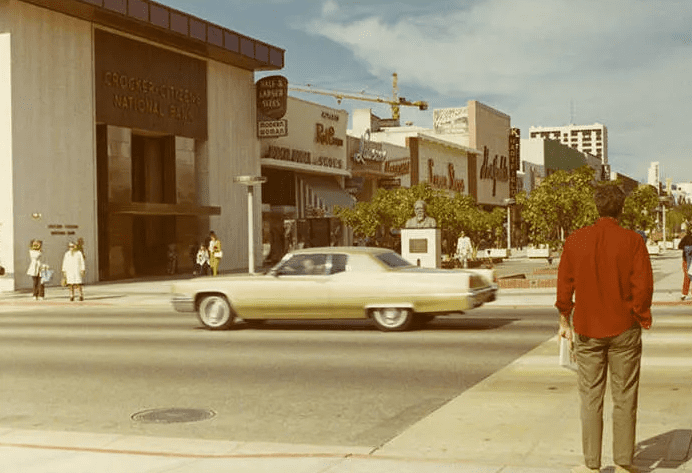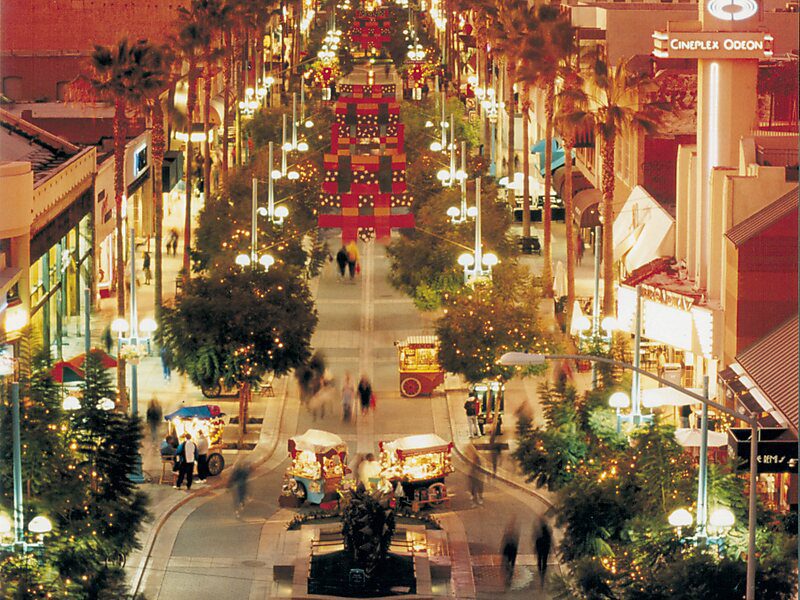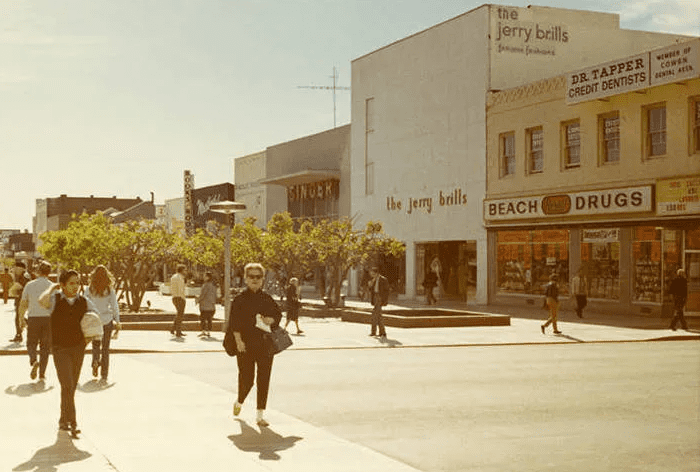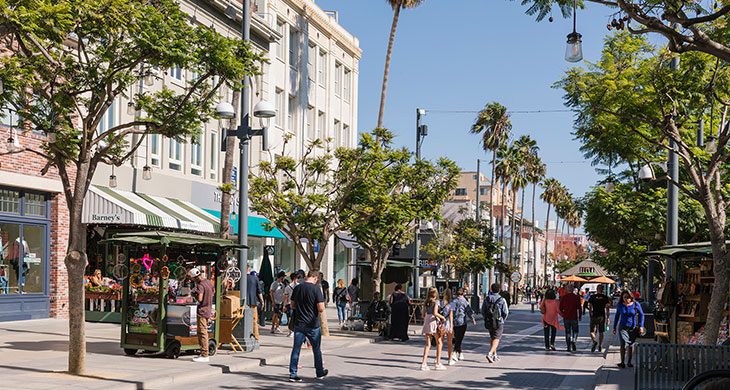As Los Angeles expanded, more shopping centers began to appear. The city was exhausted because of extremely developed trade. Santa Monica is a prime example of this. The website LA-future will tell more about the transformation of the pedestrian mall.
Bustling and busy commercial city center
This is the perfect description of Santa Monica. The Third Street in the center was filled with offices and public organizations. Among many kinds of establishments, there were also those designed for entertainment.
Back then, Santa Monica looked like a somewhat shabby neighborhood, so local business leaders were well aware that something had to be done about it. This street was predicted to have an unpromising future, namely to become a ghost, but this did not happen. As a result, the Third Street Promenade became the most popular pedestrian street in Southern California.

Santa Monica and blocking Third Street for motorists
In 1959, city authorities began to seek solutions on how to change the situation. Based on the experience of the state of Michigan, where cars were banned from the shopping streets, an unexpected answer was found. An automobile culture was pushed aside because this street was supposed to become a pedestrian area.
In 1954, Victor Gruen designed the first open-air shopping center in the suburbs of Detroit. In 1960, the Santa Monica Chamber of Commerce contacted the man, and he recommended converting Third Street into a pedestrian mall.
More than 65% of merchants accepted this plan, but some did not like the idea much. The management of the company Ralphs, which operated the supermarket at Third and Wilshire, became one of the obstacles. By 1965, all legal and political difficulties had been overcome.
A group of architects designed an open-air pedestrian zone consisting of three blocks. This area was decorated with flower gardens, trees and fountains.
The grand opening and celebration took place on November 8, 1965.

Initial success
The pedestrian mall was on the rise. Many local companies and businesses even had to close because of that. In 1981, Santa Monica Place was opened. It was an enclosed three-level building designed by Frank Gehry. The reaction to this building was the opposite of the expectations.
In 1987, the Los Angeles Times reported that the pedestrian mall promenade had become the heart of Santa Monica, but at the same time, it had become its affliction. It turned out that over time the number of homeless already exceeded the number of buyers and visitors to the district. That is why after great success came a time of decline.

Revival of the Third Street Promenade
In 1987, the pedestrian mall was experiencing a significant decline in popularity. Most of the locals and city leaders were convinced that the best days were long gone. But Santa Monica deserved a second chance.
Los Angeles designer Alan Loomis shared some interesting thoughts on this matter. He noted that in order to double the concept of a pedestrian shopping center, it was decided to build the Third Street Promenade in 1989. Major changes took place, which were manifested in the following:
- redesign
- two-year reconstruction
- major renovation, including parking, unusual trees, fountains and other cosmetic repairs
- change of names.
Therefore, this place again became the most famous and popular in LA. In 1987, city authorities thus tried to prevent the migration of businesses from downtown Los Angeles to the suburbs. Visitors were attracted by the opportunity to make a purchase for free.
About 200 cities and small towns across America tried to apply this experience but did not succeed. The example of Santa Monica illustrates well how to achieve popularity and recognition.
As said designer Alan Loomis, in case of misfortune, the Street would simply be allowed for car drivers again.

A new style of Promenade
Following renovations, retail trade continued to operate on Third Street, but not only this business was run there:
- live comedy appeared, and Second City took over the Mayfair Theater
- later, in the early 90s, Cineplex Odeon opened a 4-room multiplex
- restaurants began to open. Thus, all the townspeople and vacationers had a reason to stay in Santa Monica for the evening.

Golden Years of the Promenade
The 1990s are considered the golden age of the Promenade. The success of the project was, at the same time, its drawback. No one could have predicted that real estate and rental prices in Santa Monica would skyrocket. In the 2000s, there was even a national chain store located on the embankment. Most guests began to realize they were missing the main thing, the local flavor that had disappeared.
Third Street Promenade: curious facts
The Promenade consists of 3 blocks (between Broadway and Wilshire Boulevard) and is located in the very heart of Santa Monica. This prosperous pedestrian mall in the USA is distinguished for its multifunctionality and good reputation among tourists. The Promenade is about 0.6 km long. In total, there are more than 60 shops and 25 restaurants, cafes, fast food establishments as well as excellent entertainment venues, cinemas and bars, clubs, and places for performances on 3rd Street. Here are some curious facts about the area.
- Third Street has one of its most famous entertainments, an eclectic mix of street musicians and artists.
- Farm markets work every Wednesday and Saturday in central Santa Monica, which is a chance to stroll along the esplanade and pick up the freshest and tastiest food.
- The architectural firm ROMA Design Group was involved in the reconstruction of Third Street in 1989.
- In 2007, Los Angeles’ authority introduced a property assessment for downtown reconstruction. The initiative is funded by tenants within the district. The projects include improved maintenance, new services, infrastructure updating, marketing and others.
- In 2010, Santa Monica Place (a covered shopping center) was redeveloped into a luxury mall by Omniplan architects from Dallas. This event caused controversial feelings. At that time, the establishment was perceived extremely negatively, while the new center was warmly welcomed with positive reviews.

Santa Monica’s potential problems
There are several aspects that can be highlighted:
- Third Street is often criticized for losing its identity. For example, identical stores and restaurants tend to open there. However, there are ideas regarding the pier renewal, which can become a carte-de-visite of the district
- traffic jams on Santa Monica Boulevard, Arizona Avenue and Wilshire Boulevard raise concerns for local residents. Overcrowded parking areas are also one of the problems
- residents of this area criticize the high-end shops opening in Santa Monica because they do not meet the needs of the townspeople.
Annually, over 11 million people visit this district. It becomes a great public space where people can socialize, go shopping and have fun. Subsequently, a new project, Promenade 3.0, was developed by Rios Clementi Hale Studios company. This pedestrian mall is the heart of Santa Monica.
Third Street faced many challenges but could transform from a dirt road of the Wild West into a luxury commercial project.



